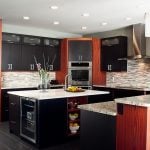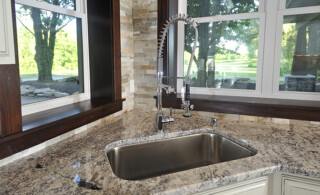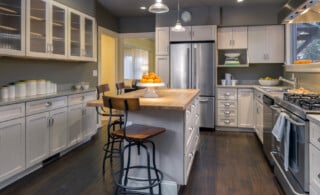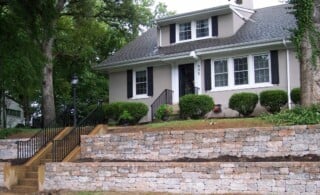
HomeAdvisor’s latest State of Home Spending Report, based on a survey of nearly 1,500 homeowners nationwide, confirmed several hunches we’ve had about the industry, starting with the idea that Americans are investing in their homes more than ever. In fact, home improvement spending is up 17% from last year, to just over $9,000.
But the survey also yielded findings that run counter to common perceptions about home improvement. Here are five of the biggest myths debunked by this year’s report—and what the reality could mean to you.
Myth #1: Old homes cost more to maintain
The stereotypical money pit is a creaky old house that’s in a constant state of disrepair. But our survey found that higher home age does not predict higher emergency spending on things like leaky roofs and failing furnaces. It’s the opposite actually, with homeowners spending an average of $3.70 less in emergency spending per year for every year their home was built. In other words, the owner of a 100-year-old house will spend about $370 less per year on emergency spending than the owner of a new house.
The reason might have to do with the fact that owners of older homes have already addressed major issues—updating the heating equipment, for example, or putting on a new roof. A home built twenty years ago, on the other hand, might be just about due for these improvements.
Takeaway: older homes can perform like new, if they’re properly maintained.
Myth #2: The kitchen is the most frequently remodeled room
That used to be the case. But according to our survey, the bathroom has taken up the mantle of most remodeled room. Of the nearly 600 people who said they completed a room remodel, 58% redid a bathroom, compared with 32% who tackled the kitchen.
Part of the reason could simply be the fact that there are more bathrooms out there than kitchens. But that’s always been true. A more likely driver is the steady uptick in first-time homebuyers (Millennials have been the largest homebuying cohort for several years now). With many of these new owners in prime family-rearing mode, having multiple updated bathrooms is a must.
Takeaway: if you’re getting ready to sell, sprucing up the bathrooms will attract more buyers and probably increase your final sale price.
Myth #3: Millennials are all about appearances
That might be true with their Instagram feeds, but when it comes to their homes, Gen Yers are exceedingly value-driven. In our survey, Millennials were more than twice as likely as Generation X to list adding value to their home as a key motivator for home improvement projects, and about three to four times as likely relative to baby boomers and the silent generation.
The laser focus on ROI is likely because so many Millennials reached the homeownership station life in a tougher financial situation than prior generations, thanks to student debt, stricter mortgage regulations, and rising home prices.
Takeaway: Home sellers should play up value-driven features, such as new windows, updated water heater, and energy-efficient appliances.
Myth #4: Most homeowners are not prepared for emergency repairs
While it’s true that many Americans aren’t saving enough, be it for retirement or a rainy-day fund, our survey sounds a more optimistic note, at least for homeowners. To wit, 87% of respondents said they have $1,000 available for an emergency repair.
While many factors are at play, the most important is likely the fact that homes are an effective form of ‘forced’ savings that encourages steady equity building.
Takeaway: Homeownership is a great way to grow wealth, but it requires a certain degree of responsibility and planning.
Myth #5: The GOP is the party of homeownership
Conventional wisdom is that Republicans own their homes, while Democrats rent. Our survey tells a different story. Take family values: the 37% of Republicans who reported having children under the age of 18 at home was only slightly higher than the 33% of Democrats in that situation. Or look at home worth: Democrats average $225,000, compared with $235,000 for Republicans. Finally, our survey found that blue and red voters are equally prepared to handle an emergency repair.
Takeaway: While Democrats and Republicans are divided on many issues, they clearly agree on the benefits of homeownership.
 2015 True Cost Report & Homeowner Insights
2015 True Cost Report & Homeowner Insights  HomeAdvisor: Sink Installations Surge in 2016
HomeAdvisor: Sink Installations Surge in 2016  Nesting Is Investing
Nesting Is Investing  Urban Remodeling Trends in San Francisco, CA
Urban Remodeling Trends in San Francisco, CA  Prospective 2017 Home Improvement Trends: First-Timers and Fixer-Uppers
Prospective 2017 Home Improvement Trends: First-Timers and Fixer-Uppers 

I’m a retired general contractor that specialized in antique home restoration. I can unequivocally say that this story has much merit. I’ve owned more than 100 ‘old’ homes which I have restored. My last residence was an antique farmhouse built in 1679. Currently I live in a home built in 1988, my youngest ever. There is no doubt you spend more money maintaining a newer home than you do an older one which likely has had many upgrades, especially to the more costly items like HVAC, electrical, kitchens, baths, roofs and siding.